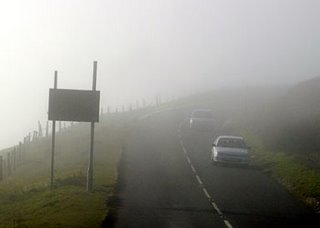 California is now in the group of environmentally conscious states leading the nation, passing the toughest law regarding CO2 emessions. The Washington Post carried the story, from which comes this exerpt:
California is now in the group of environmentally conscious states leading the nation, passing the toughest law regarding CO2 emessions. The Washington Post carried the story, from which comes this exerpt:California's legislature approved the broadest restrictions on carbon dioxide emissions in the nation yesterday, marking a new stage in the accelerating drive for a more aggressive national response to global warming. . .
California lawmakers, along with environmental advocates and some business leaders, said they pushed the measure both to address what they see as a threat to their state's economic and environmental welfare, and to influence national energy policy.
"I really believe the effort to curb global warming is a bottom-up effort in this country," Assembly Speaker Fabian Nuñez (D), who is a co-author of the bill, said in an interview Wednesday. "For us, this is not just about California. This is about making a push from the bottom up to get the Congress to take action."
Advocates would have to overcome major obstacles to bring about a national program, however. Both the House and the Senate have rejected mandatory limits on carbon dioxide. But if Democrats make gains in this fall's elections, it could bolster support on Capitol Hill for a universal cap-and-trade system.
California is now leading a movement among the states on improving the environment, CNN reports. Quoting the story,
State a leader in cutting auto emissions: California has led the country in reducing greenhouse gas emissions through its renewable energy policies and a 2004 law reducing tailpipe emissions from vehicles.What about the feds? It might make something also happen at the federal level, according to the New York Times. To quote (my link added),
Ten other states are poised to enact California's auto rule, while more than 20 states have required utilities to eventually generate some power from renewable sources such as solar, wind and geothermal.
The state’s action, he said, could set off a “bottom-up” movement for curbs of heat-trapping gases in states around the country.Democrats helped - Carl Pope, ED of the Sierra Club, writes in Taking the Initiative that "Democratic leaders in the legislature refused to give in to the Governor's urgings to water the bill down. . . "
That has been the goal of national environmental groups like Environmental Defense and the Natural Resources Defense Council, which helped sponsor the California legislation. It has also been the goal of Ms. Pavley, a Democrat from Agoura Hills and the author, in 2002, of a groundbreaking law reducing tailpipe emissions of
heat-trapping gases.
Already, the governors of New York, New Jersey, Delaware and four New England states have signed an agreement to curb power-plant emissions, cutting them by 10 percent by 2019. That would amount to about 24 million tons, said Dale Bryk of the New York office of the Natural Resources Defense Council, about one-seventh of the total envisioned in the California legislation, which will be an estimated 174 million tons.
The situation here and abroad is of continual concern to me. I regularly monitor the quality of the air we breathe and it is often awful. Nor is the situation all around the world improving very much. Yahoo!News reports that greenhouse gases are up, despite Kyoto. To quote,
Emissions from 40 industrial nations climbed 1.6 percent overall to 17.8 billion metric tons of carbon dioxide -- mainly from power plants, factories and cars --References:
in 2004 from in 2003 even though oil prices were surging. . .
"We're not on track to solve climate change by any stretch of the imagination," said Alex Haxeltine, an expert at the University of East Anglia in England. Governments were doing little to plan for cuts in emissions beyond Kyoto, he added.
Most of the 2004 rise was caused by a 1.7 percent gain in emissions in the United States, the world's biggest source of greenhouse gases, to a record 7.07 billion metric
tons. Emissions in the European Union and Canada also rose while Japan's dipped.
Most Industrialized nations except the United States and Australia have ratified Kyoto, which obliges an overall cut in emissions of at least 5.2 percent below 1990 levels by 2008-12 with a shift to cleaner energies such as wind and solar power.
- Environmental Protection Agency - U.S. government site
- Environmental Law Reporter - a very comprehensive set of the best links
- Natural Resources Defense Council - excellent site of importan activist group
- State Environmental Law list (a U.S. Navy site not updated since 3/14/02)
Tags: articles current affairs health and wellness environment News Politics
No comments:
Post a Comment